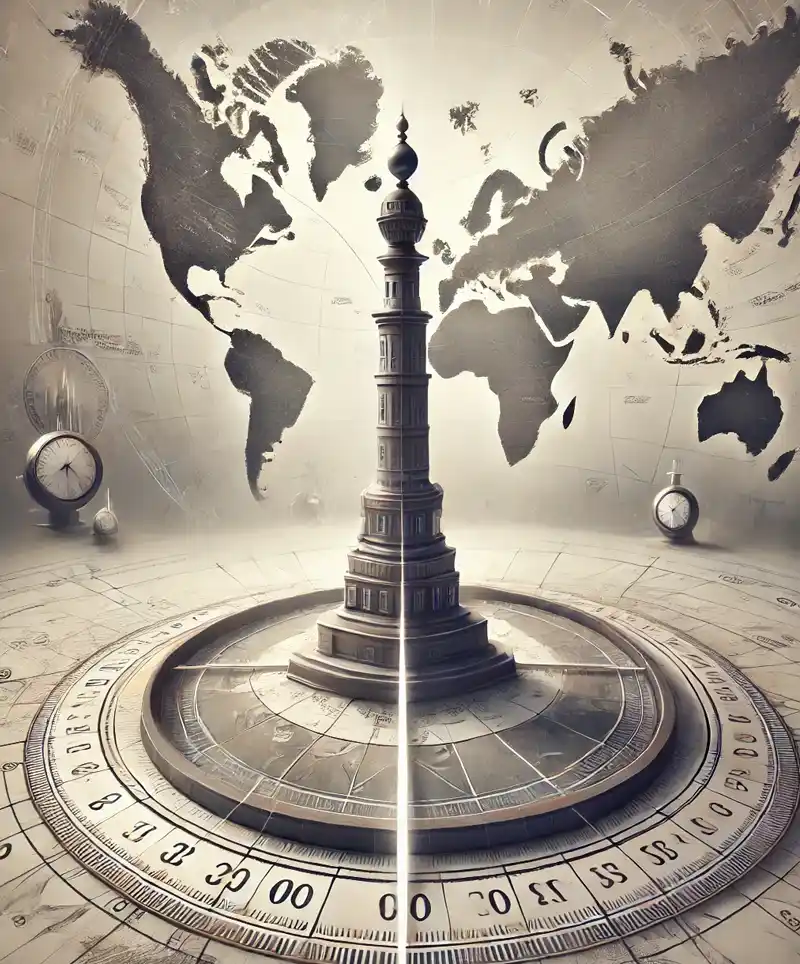The Celebration of the Invisible Line that Keeps Us All in Time
Every year, on November 1st, we observe Prime Meridian Day—a day dedicated to the magical line that runs through Greenwich, England, and keeps the entire world in sync. While the Prime Meridian itself isn’t visible, its role in helping humans organize time and space has been monumental. So, let’s take a light-hearted yet factual journey down this longitudinal landmark to explore its history, significance, and perhaps even its quirky side.
What is the Prime Meridian, Anyway?
The Prime Meridian is the line of 0° longitude that runs from the North Pole to the South Pole. This line was established as the global starting point for time and is what gives us Greenwich Mean Time (GMT). Before its establishment, different countries—and even different cities—used their own local times based on the sun’s position in the sky. Imagine the chaos! Trains couldn’t keep schedules, sailors were perpetually lost, and afternoon tea was anyone’s guess.
Enter the Prime Meridian. In 1884, a group of delegates from 25 nations met in Washington, D.C., for the International Meridian Conference. The main agenda? To decide on one universal line that would unify timekeeping around the globe. After some debate (and maybe a few cups of coffee), Greenwich, England, got the honor. Since then, the world has had a single, imaginary line to help coordinate clocks, navigate the seas, and even help find lost socks… well, almost.
A Brief History of the Prime Meridian
Before the Prime Meridian was universally accepted, the idea of mapping the Earth was already well underway. Early astronomers and navigators used the stars, the moon, and even the ocean’s currents to navigate, but reliable, global coordination was missing. The establishment of the Prime Meridian allowed for a new system of global navigation, dividing the Earth into hemispheres and enabling coordinated world travel and commerce.
Interestingly, England was just one contender for the Prime Meridian. Paris, for instance, also wanted the honor—after all, they’d been using their own meridian since the days of Louis XIV. But England’s long history of naval dominance and scientific research at the Royal Observatory in Greenwich gave it the upper hand. Ultimately, 22 out of 25 nations voted in favor of Greenwich as the starting point for 0° longitude, setting a “world standard” with a British twist.
 With the Prime Meridian established, Greenwich Mean Time became the universal standard. But things got a little complicated. GMT gave way to Coordinated Universal Time (UTC) in 1967, which accounts for minor discrepancies between Earth’s rotation and atomic time. Yet GMT lives on, especially in popular phrases like “What’s the GMT on that meeting?” or the confusion during “spring forward” or “fall back.”
With the Prime Meridian established, Greenwich Mean Time became the universal standard. But things got a little complicated. GMT gave way to Coordinated Universal Time (UTC) in 1967, which accounts for minor discrepancies between Earth’s rotation and atomic time. Yet GMT lives on, especially in popular phrases like “What’s the GMT on that meeting?” or the confusion during “spring forward” or “fall back.”
Today, UTC is the official keeper of global time, while the Prime Meridian serves as the spatial anchor. This means that when you’re Googling time zones and wondering why your cousin in Sydney can’t make your morning Zoom, you can thank the Prime Meridian for the order and time difference.
Celebrating Prime Meridian Day
So, how exactly does one celebrate Prime Meridian Day? It’s not like you can visit the Prime Meridian for a party; it’s an invisible line, after all! But don’t worry, there are plenty of ways to honor this critical piece of geographical history:
1. Take a Trip to Greenwich (or Have a Virtual Visit!)
For those who happen to be near London, a trip to the Royal Observatory in Greenwich is the perfect way to celebrate. You can straddle the line with one foot in the Eastern Hemisphere and one in the Western Hemisphere, making it the ultimate balancing act. Can’t make it there? A virtual tour of the Royal Observatory allows you to view where it all began from the comfort of your couch.
2. Set Your Watch to GMT for the Day
Why not live by Greenwich Mean Time for a day? Adjust your clocks, phones, and computers to GMT and see if you can keep up with the world on a completely different time schedule. You may feel like you’re living in the past—or future, depending on where you are—but it’s a fun way to remind yourself of the power of time zones.
3. Practice a Bit of Latitude and Longitude Navigation
While you might not have a sextant handy, try locating a few coordinates online or brushing up on some basic map-reading skills. Practice locating famous landmarks by their coordinates. You’ll be amazed at the accuracy and the satisfaction of locating the Eiffel Tower or Mount Kilimanjaro with just a few digits and a click.
4. Test Your Time Zone Knowledge
Challenge your friends to a time zone quiz! Create questions about which cities fall into specific time zones or ask them to identify the current time in different parts of the world. You’d be surprised how quickly time zones can become a fun—and competitive—topic.
5. Ponder the Mystery of “Why Time Flies”
Contemplate how time flies when you’re having fun and seems to slow down when you’re stuck in a meeting. The Prime Meridian’s role in time might be straightforward, but the way time feels is a mystery that still perplexes philosophers and physicists alike. Perhaps a bit of existential reflection is the ultimate Prime Meridian Day activity.
Fun Facts About the Prime Meridian (Because Every Day Needs Trivia)
-
It’s Not Set in Stone: The Earth wobbles on its axis ever so slightly, so the precise location of the Prime Meridian shifts ever so slightly over time. Scientists account for this with atomic timekeeping, but the Prime Meridian is, in theory, on the move!
-
It Splits the Planet: The Prime Meridian divides the Earth into two halves: the Eastern and Western Hemispheres. It’s like an imaginary knife cutting through the globe, but thankfully, no one gets hurt!
-
It’s Not Alone: While the Prime Meridian is the most famous meridian, every degree of longitude has its own meridian, totaling 360 around the Earth. The Prime Meridian just happens to be the “original.”
-
GPS and the Prime Meridian: Modern GPS is based on the concept of the Prime Meridian and latitude-longitude coordinates. So, every time you use GPS, you’re in sync with a concept developed in Greenwich over 100 years ago!
Though it’s easy to take the Prime Meridian for granted, its significance remains clear in our increasingly connected world. Imagine trying to organize global events, flights, or satellite launches without a universal point of time and location reference. The Prime Meridian allows us to synchronize, schedule, and stay oriented in a world that’s constantly moving.
Whether it’s planning an international call or simply marveling at how you can track a plane from Tokyo to New York in real time, the Prime Meridian is there, silently keeping everything in line. And while it may never get the fanfare of New Year’s Day or even Pi Day, Prime Meridian Day deserves a bit of respect—and maybe a toast in GMT, wherever you are.
So, on this Prime Meridian Day, raise an imaginary line in honor of the invisible line that shapes our world, grounds our GPS, and helps us connect across time and space. You may never actually “see” the Prime Meridian, but, like most things in life, just knowing it’s there can make all the difference.
Please Share our Content






 With the Prime Meridian established, Greenwich Mean Time became the universal standard. But things got a little complicated. GMT gave way to Coordinated Universal Time (UTC) in 1967, which accounts for minor discrepancies between Earth’s rotation and atomic time. Yet GMT lives on, especially in popular phrases like “What’s the GMT on that meeting?” or the confusion during “spring forward” or “fall back.”
With the Prime Meridian established, Greenwich Mean Time became the universal standard. But things got a little complicated. GMT gave way to Coordinated Universal Time (UTC) in 1967, which accounts for minor discrepancies between Earth’s rotation and atomic time. Yet GMT lives on, especially in popular phrases like “What’s the GMT on that meeting?” or the confusion during “spring forward” or “fall back.”








 "Sláinte!" is a traditional Irish expression used as a toast, equivalent to "Cheers!" in English.
"Sláinte!" is a traditional Irish expression used as a toast, equivalent to "Cheers!" in English.